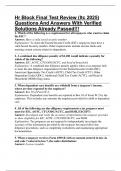Hr Block Final Test Review (Itc 2025)
Questions And Answers With Verified
Solutions Already Passed!!!
1. Which of the following is a requirement for all taxpayers who want to claim
the EIC?
Answer: Have a valid social security number.
Explanation: To claim the Earned Income Credit (EIC), taxpayers must have a
valid Social Security number. Other requirements include income limits and
meeting certain criteria related to dependents.
2. A combined due diligence penalty of $2,180 would indicate a penalty for
which of the following?
Answer: EIC, AOTC, CTC/ODC/ACTC, and head of household.
Explanation: A combined due diligence penalty applies when a tax preparer fails
to meet the due diligence requirements for the Earned Income Credit (EIC),
American Opportunity Tax Credit (AOTC), Child Tax Credit (CTC), Other
Dependent Credit (ODC), Additional Child Tax Credit (ACTC), and Head of
Household (HOH) filing status.
3. When dependent care benefits are withheld from a taxpayer's income,
where are they reported by the employer?
Answer: Box 10 of Form W-2.
Explanation: Dependent care benefits are reported in Box 10 of Form W-2 by the
employer. This includes any amounts the employer provided for child or dependent
care.
4. All of the following are due diligence requirements a tax preparer must
meet for EIC, AOTC, CTC/ODC/ACTC, and HOH, EXCEPT:
Answer: Investigate and verify the accuracy of information the taxpayer provides
to show eligibility for EIC, AOTC, CTC/ODC/ACTC, and HOH.
Explanation: Tax preparers are not required to independently investigate the
accuracy of the information provided by the taxpayer but must follow due
diligence procedures, such as completing worksheets and maintaining appropriate
documentation.
5. When a taxpayer receives Form 1099-R with no amount entered in box 2a
and code 7 entered in box 7, the entire distribution:
Answer: Is never taxable.
,Explanation: If box 2a is empty and code 7 is used, it usually indicates that the
distribution was a normal distribution from a retirement account and it was not
taxable, possibly due to being rolled over into another qualified plan.
6. What is the maximum amount of the American Opportunity Tax Credit a
taxpayer could receive per student?
Answer: $2,500.
Explanation: The American Opportunity Tax Credit (AOTC) allows for a
maximum of $2,500 per eligible student.
7. Which test for a qualifying child does NOT need to be met in order for the
child to be a qualifying person for purposes of Earned Income Credit (EIC)?
Answer: Support.
Explanation: To qualify for EIC, a child must meet criteria for age, relationship,
and residency. The "support" test is not necessary for EIC, but it may be for other
credits.
8. Which of the following expenses qualifies for an education credit in 2021?
Answer: Tuition payments. The taxpayer didn't receive scholarships, grants, or
other nontaxable benefits.
Explanation: Tuition payments qualify for education credits like the AOTC, as
long as they are not covered by scholarships or grants that are not taxable.
9. Employer-provided dependent care assistance:
Answer: May be used for the Child and Dependent Care Credit.
Explanation: Employer-provided dependent care assistance may be used for the
Child and Dependent Care Credit and is reported in Box 10 of Form W-2.
10. Which of the following is NOT a percentage of social security benefits
subject to federal tax? Up to __________.
Answer: 100%
Explanation: Social Security benefits are subject to tax up to 85%, but not 100%.
11. What is the maximum amount of the lifetime learning credit?
Answer: $2,000 per return.
Explanation: The Lifetime Learning Credit allows for up to $2,000 per return,
regardless of the number of students.
12. Employer-provided dependent care assistance:
Answer: It may be used for the Child and Dependent Care Credit.
, Explanation: Employer-provided dependent care assistance can be used in
conjunction with the Child and Dependent Care Credit to reduce taxable income.
13. Earned Income
Answer: Any income (wages/salary) that is generated by working.
Explanation: Earned income includes wages, salaries, tips, and other taxable
income derived from employment or self-employment.
14. Unearned Income
Answer: Include interest income, dividends, rents and royalties, pensions,
alimony, and unemployment income.
Explanation: Unearned income includes income derived from investments,
government benefits, and other sources that do not require work for earning.
15. If an employee thinks their Form W-2 is incorrect, what should they do?
Answer: If the taxpayer's name, social security number, earnings, or withholdings
are incorrect, the taxpayer should notify their employer and request a corrected
Form W-2. The employee should request that the employer update their records
and verify that the earnings were properly credited with the Social Security
Administration. However, the taxpayer is still responsible for filing a timely tax
return. If the employee's attempts to obtain a corrected Form W-2 from their
employer are not successful, the taxpayer should notify the IRS. It may be
necessary to prepare a substitute Form W-2.
Explanation: If there is an error on Form W-2, the employee should first request a
correction from their employer and ensure their records are updated. If
unsuccessful, they should contact the IRS and potentially file a substitute W-2.
.
Is interest received on U.S. Treasury obligations taxable on state and/or local
returns?
Answer: No. Interest on U.S. Treasury obligations is exempt from state and local
tax by federal law.
Is municipal bond interest taxable on a federal return?
Answer: No, the federal government does not tax municipal bond interest.
How is interest income reported to the taxpayer?
Answer: Interest income is reported to the taxpayer on Form 1099-INT or a
substitute statement.




